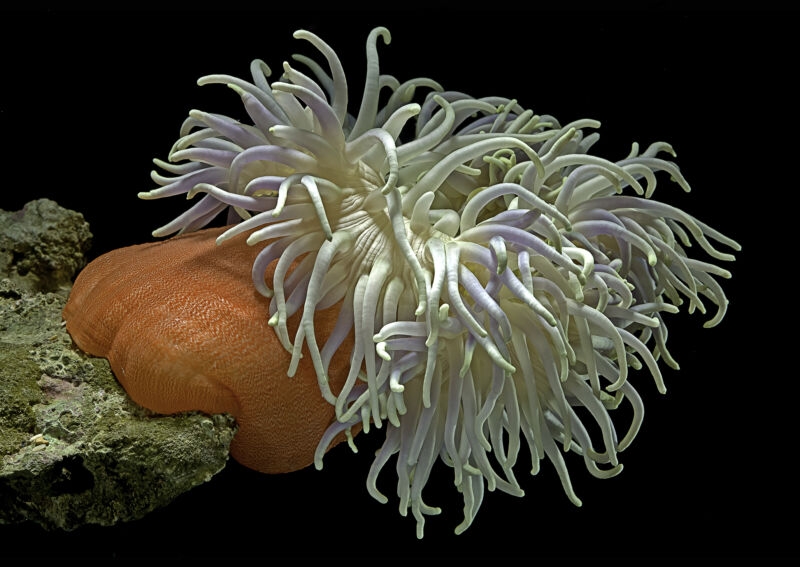
Our brains are full of specialized structures that perform tasks such as processing visual information, processing memory, or interpreting language. One way to try to understand what the brain is capable of is to compare it to the brains of other species; What is the structure of the brain and what behavior does this brain support?
What if the animal had no brain? Presumably, most of the behaviors we study require at least some central nervous system input. But there are many species, including anemones, corals and jellyfish, that have quite elaborate neural networks and nothing like a brain. But, apparently, this is enough for collaborative learning, which is often (forgive me) associated with Ivan Pavlov.
Do we study cnidarian?
Collaborative learning looks like this. In Pavlov's case, he trained dogs to associate a certain sound with food. After training, the dogs began to salivate when they heard the sound, even when there was no food. A large number of animals are capable of associative learning, and it is easy to see how this could provide a selective advantage.
But what brain is needed for this? Cnidarians , which range from tiny hydras to giant jellyfish, lack a centralized structure that we recognize as a brain. Instead, they have a distributed network of neurons called a neural network. It is clear that neural networks can coordinate the actions of the entire body, as we can see how jellyfish swim through rhythmic contractions. Cnidarians can respond to environmental stimuli; Some of them have eye structures. So, although a neural network lacks the specialized structure found in the brain, it is clearly capable of performing some of the functions we normally associate with the brain.
(Cnidarians are unlike bipeds like us, which have opposite sides.)
But can he handle the training? A team of European researchers (Gayle Bouton-Amiot, Pedro Martinez and Simon Sprecher) looked at this question and found it largely unanswered. There have been some papers that have suggested that certain chidarians can form stable associative memory, but there hasn't really been much research on this, and no one has followed up on the original work.
Surprises Anemone
Their experiment was surprisingly simple, resulting in a very compact and understandable research document. The researchers knew that anemones could sense light (they worked with a species called Nematostella vectensis ), although other cnidarians lack visible eyes. Thus, they combined light exposure with an unpleasant sensation, such as an electric shock.
The impact itself causes the animals to contract their bodies and retract their tentacles. About 20% of animals will react the same way when exposed to light. But during an hour of training in which the animals were given repeated electric lights and electric shocks, the situation changed dramatically. The percentage of animals responding to light alone halved to about 10%. Shock alone produced a similar frequency of responses.
To get a permanent contraction, the researchers had to apply light and electric shocks simultaneously, which caused about 70% of the animals to contract. (This is less than the "strong, rapid, reversible contractions" seen at the start of the experiment, but by this point the animals had been shocked for over an hour and were expected to have some degree of adaptation.) A one-minute shock induced contractions, but less frequently ( about 30% of cases).
Thus, this is not Pavlovian conditioning as seen in dogs, where the animal learns an association in a way that allows it to respond to an unrelated cue. Instead, the animals learned to interpret both stimuli as triggers, so they had to respond to both.
All of this suggests that there must be some form of central coordination within the neural network to allow the animal to integrate environmental signals and produce responses that involve most parts of the body. Many cnidarians have areas of neural networks with a high density of neurons, but they do not seem to be associated with any specific function. Therefore, it is not clear whether this memory and coordination is related to physical structure.
These results can be interpreted in light of recent findings showing that disorganized neurons in culture dishes can "learn" to play ping-pong . This has been interpreted as an indication that neurons first form expectations about the inputs they will receive and adjust their behavior when these inputs do not match. Such behavior can create associative memories without the need for a central organization. This also implies that the neural network should be able to easily learn the association if the two triggers are not associated, which would be very easy to test.
PNAS, 2023. DOI: 10.1073/pnas.2220685120 (in DOI).


Post a Comment
Post a Comment